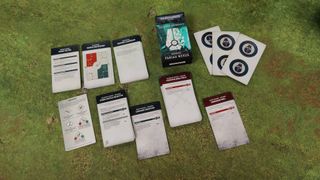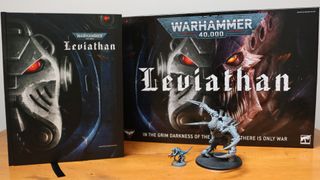Warhammer 40K mixes up the missions with Pariah Nexus, but should you buy it?
Pariah Nexus introduces Secret Missions and the return of Actions to Warhammer 40K 10th Edition

When Warhammer 40K 10th Edition dropped last year, it came with the Leviathan mission pack and the tantalizing promise of future card decks to keep the game fresh. After a year of the Leviathan missions, that promise has finally been fulfilled with the arrival of the Pariah Nexus Mission Deck, which shakes up the game with some significant changes to how we deploy our armies and score points.
For the most part, these changes are great moves in the right direction; they remove easy objectives and annoying deployment maps from Warhammer 40K while adding in some new ones to replace them. But before we dive into what’s actually changed here, a word of warning (and a scolding for Games Workshop). The Pariah Nexus Mission Deck is currently rarer than Kroot’s teeth. GW seems to have massively underestimated demand and the deck has been sold out everywhere since its release back in late June, an issue it's faced before with the likes of Cursed City (which is somewhat infamous for those stock problems, even if it makes up for this by being one of the best board games the company has put out). Even I don’t have a deck yet — I’m borrowing this one from a buddy who had the foresight to pre-order one. If you don’t have access to the cards and you want to play competitive 40K, then check out the Tabletop Battles app. This app lets you score your games and has all the up-to-date missions and objectives you’ll need.
Back in action

The way that you set-up and play a game of Warhammer 40K goes largely unchanged in Pariah Nexus. You draw a deployment map, primary mission, and mission rule (or use one of Games Workshop’s approved presets). You also draw cards from the Secondary mission deck throughout the game. There have been some notable changes though, starting with the return of Actions.
Anyone who played during 9th Edition 40K will recognise the return of Actions as a formalized rule. Units can perform Actions to score points at the cost of forgoing their option to shoot or charge. These rules kinda existed in the Leviathan Mission Deck, but they weren’t formally codified — some cards just said stand here, don’t shoot, and you score points.

It feels like all change across the board; 40K's sister game is also getting updates, and the new edition of Warhammer Kill Team fixes a weird rule I've always disliked.
These pseudo-actions caused all sorts of headaches for the rules team. Since your ability to complete them was tied to whether you were eligible to shoot, it meant that units that could advance and shoot, or shoot while in combat, could also do the pseudo-actions too.
Games Workshop clearly got tired of all these shenanigans, so now Actions are back and they’re much more restrictive than before — you can’t do them if you’re in combat, if you fall back from combat, or if you advance. This makes them tougher to pull off, which is one of the many changes that contributes to lower scoring (and hopefully closer) games in Pariah Nexus.
Masterful Gambit, sir

While actions are back in, Gambits are gone (sorry, Channing Tatum). These were introduced in 10th edition as a last throw of the dice, a Hail Mary when things weren’t going your way. You gave up your ability to score primary points in exchange for a randomly drawn Gambit — if you completed it, you scored a ton of points. Well, as it turns out, they were too hard, so no one ever took them, and now they’re gone. In their place we have Secret Missions.
Sign up to the 12DOVE Newsletter
Weekly digests, tales from the communities you love, and more
With Secret Missions, you don’t have to rest your fate on a card draw. If you’ve scored fewer Primary Mission points than your opponent at the end of the third battle round, you can choose a Secret Mission. Your Primary points get capped at 20, meaning you can still score up to 20 points if you’re currently below that mark. Then, you get another 20 points if you complete your Secret Mission.
These Secret Missions range from tasks like having your warlord take your opponents homefield objective to crippling every unit in your opponents army. Secret Missions are a massive improvement over Gambits, in that people actually use them. They also force some decisions in the list building stage and offer an exciting catch-up mechanic to players who find themselves trailing in the early stages of the game.
Your mission, should you choose to accept it

The primary missions have received a light touch when compared with some of the more sweeping changes. Some of the old missions have been axed (goodbye Priority Targets, Sites of Power, and Vital Ground) and replaced with new, better designed options, while most of the remaining roster had some tweaks to improve their overall balance.
Secondary missions received the same treatment too, with a load of the old cards getting dumped and replaced. Deploy Teleport Homers and Investigate Signals got the boot for being too easy/too hard to score respectively, being replaced with spiritual successors Establish Locus and Recover Assets — both of which require units to perform actions to complete.
Across the board, Secondary missions now give out fewer points too, which should keep game scores tighter while making each point you can score more valuable. Oh and you can still play fixed secondaries if you hate fun, but, again, the easiest fixed Secondary — Deploy Teleport Homers — is no more, so it’s a less appealing prospect than before.
One of the other big changes in the Pariah Nexus Mission deck is with the deployment maps. In the old Leviathan set, there were a couple of deployment maps that cut diagonal lines across the battlefield. This seemed logical, but it was a real nightmare to set up accurately and you’d get areas of wasted space in the corners. Pariah Nexus solves these issues by swapping out the diagonal lines for deployment zones constructed from larger and smaller rectangular sections.

This version of 40K has always felt like a big swing for GW. In our interview with the game's studio manager last year, he had this to say about designing Warhammer 40K 10th edition: "The right answer was something new."
I’m a big fan of these new layouts, and the 40K community at large seems to agree. They're easier to set up during the deployment phase, and they open up the corners of the board more and let you deploy real assets there.
Overall, Pariah Nexus feels more tightly designed than the Leviathan deck that preceded it. With a year of 10th edition under their belts now, the developers have been able to see what worked and what needed fixes. As a result, almost all of the rough edges have now been sanded off the game.
Combine this new mission update with the latest round of balance updates and Warhammer 40K 10th Edition is in a wonderful place. Pariah Nexus offers real trade offs and decision making to players, resulting in nail-bitingly close games and offering more player agency than Leviathan. Secret Missions are a wonderful second pass at a catch-up mechanic, the new deployment maps make setting up games easier, and the return of Actions smooths out a ton of janky rules interactions.
It’s just a damn shame nobody can actually buy the Pariah Nexus deck since Games Workshop decided to print like five copies of the bloody thing.
For recommendations on what to play next, check out our guide to board games for adults. As for a change of pace, don't miss the best tabletop RPGs.

Ian Stokes is an experienced writer and journalist. You'll see his words on 12DOVE from time to time, and he works as Entertainment Editor at our sister site Space.com.












